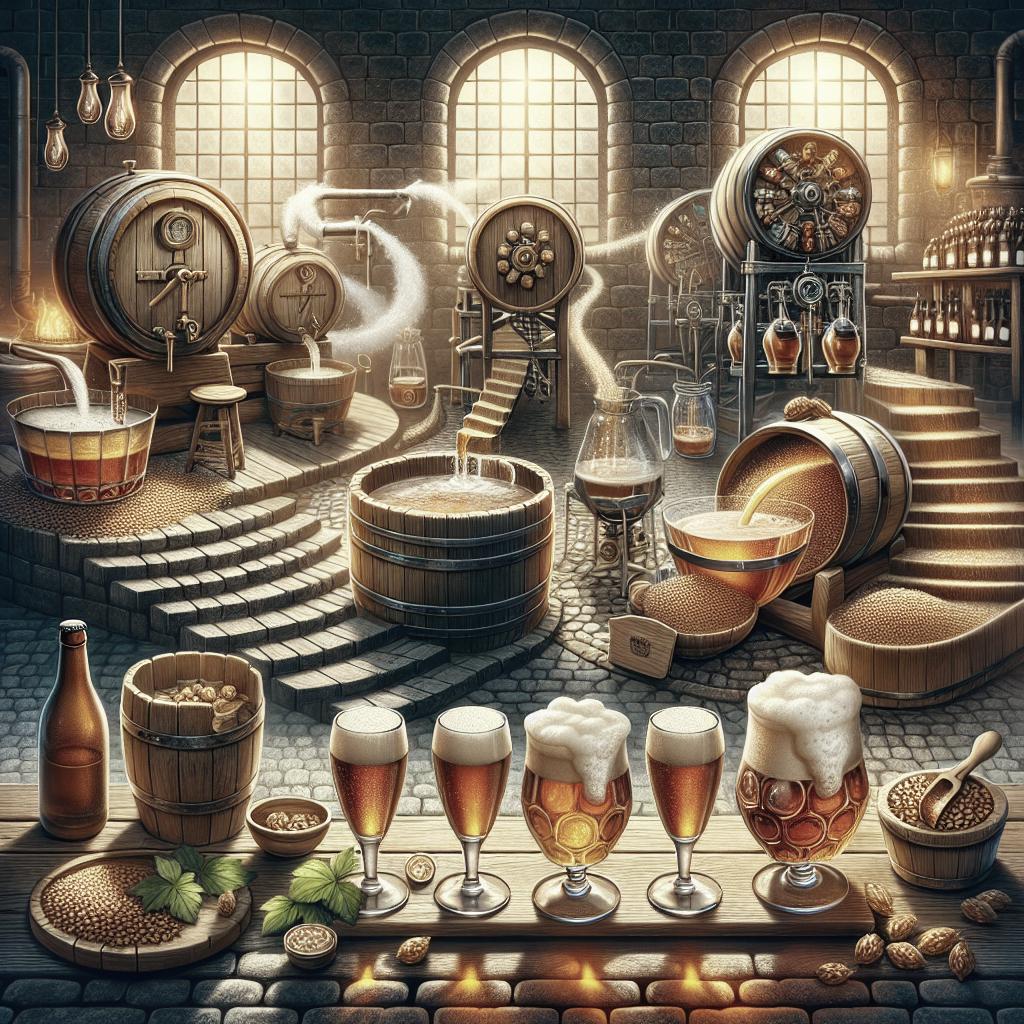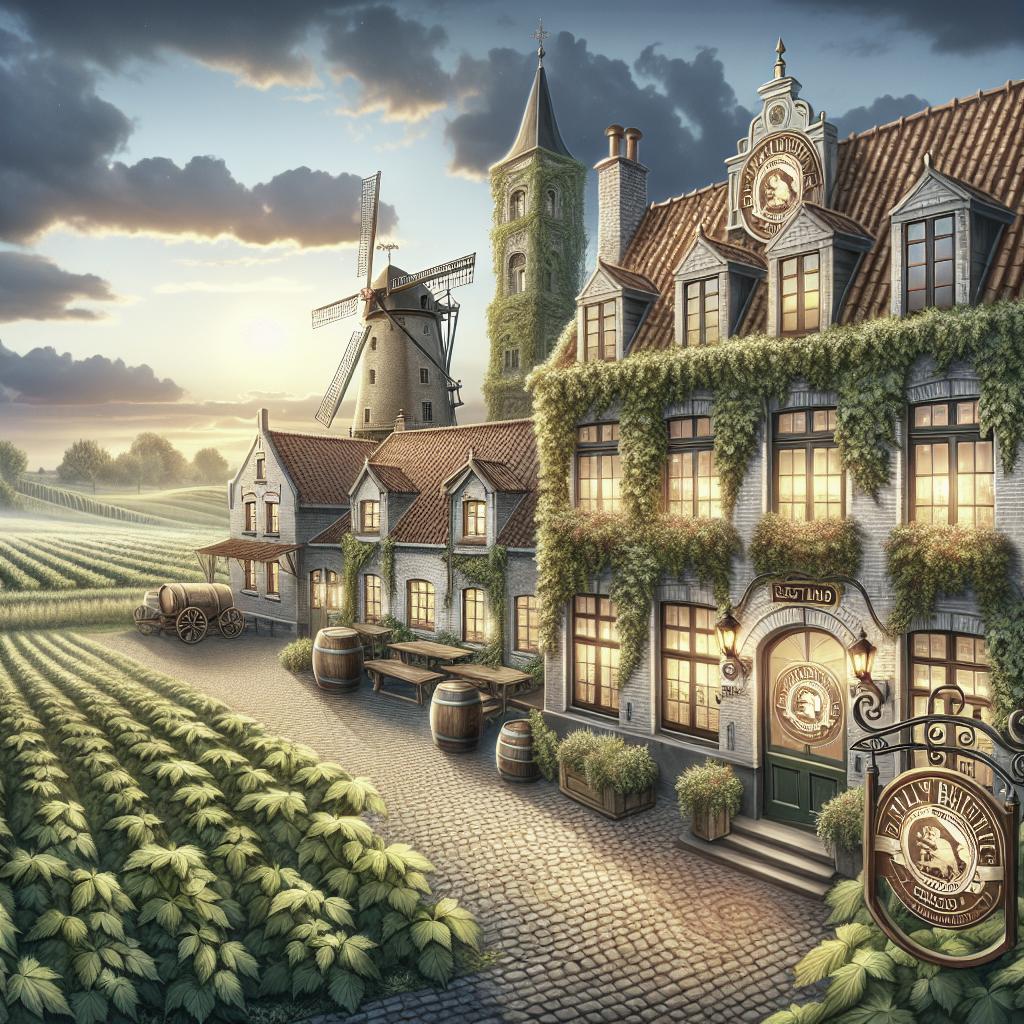“`html
Traditional Belgian Beer-Making: A Journey Through Brewing Styles
Belgian beer is heralded as one of the most diverse and celebrated beer varieties in the world, known for its rich tradition and distinct brewing methods. This article delves into the traditional methods of making Belgian beer, exploring a myriad of styles including Abbey Ales, Farmhouse Ales, and Sour Ales, among others. From the malt-heavy Dubbels and Quadrupels to the lighter Witbiers, each style boasts its own unique history and brewing process that has been honed over centuries. We’ll guide you through these styles to uncover the secrets behind each brew and bring forward their future prospects in the ever-evolving world of brewing.
Abbey Ales
Abbey ales are a cornerstone of Belgian brewing, often associated with monastic brewing traditions. These ales are typically brewed by secular breweries under license from abbeys or with abbey recipes. They are multi-layered and complex, offering drinkers a delightful experience of deep flavors and aromas.
The brewing process of Abbey ales involves top-fermenting yeast that thrives in higher temperatures, contributing to their distinct fruity and spicy profiles. A high sugar content in the wort acts as a catalyst for yeast activity, leading to higher alcohol content and a balanced taste that often includes notes of dried fruit, clove, and banana.
Dubbel, Quadrupel, and Belgian Strong Dark Ale
Dubbel is characterized by its rich, malty flavor and medium-to-full body. It’s typically marked by a sweet, caramel-like aroma and a hint of dark fruit. The traditional brewing process for a Dubbel involves the use of dark Belgian candy sugar, which not only affects the flavor but also the color and strength of the beer.
Quadrupel, often abbreviated to ‘Quad’, is one of the boldest styles, known for its immense depth and complexity. It is a dark ale with a pronounced malty profile, often seasoned with spices such as cloves and cinnamon, balancing against alcohol warmth. Belgian Strong Dark Ale shares some attributes with the Quad but can differ in alcohol strength and specific flavor derivatives based on the malt and yeast used.
Tripel
Originating from Belgian monasteries, Tripel is a strong pale ale known for its light-bodied and sweet taste. It usually contains a higher alcohol percentage than Dubbels, thanks to additional quantities of sugar added during the fermentation process, which yeast later converts into alcohol.
Tripel brewing typically requires a careful balance of malt sweetness and hoppy bitterness, all wrapped up with characteristic fruity esters and spiciness courtesy of the yeast. The crisp and dry finish of a Tripel makes it a refreshing but potent Belgian classic.
Farmhouse Ales
Farmhouse ales have rustic origins rooted in the agricultural traditions of Belgian farms. Often produced using local ingredients and spontaneous fermentation, these ales have a unique character influenced by their environment and available resources.
The fermentation process is open, allowing wild yeast and bacteria to contribute to the complexity of flavors. Farmhouse ales are unpretentious yet remarkably refined with earthy, musty, and sometimes sour notes that reflect their provenance.
Saison and Bière de Garde
Saison is a type of farmhouse ale originating from the French-speaking region of Belgium, traditionally brewed in the cooler months and stored for summer use. Known for its dry, fruity, and peppery flavor profile, Saison often highlights a spicy zest from the yeast and subtle hoppiness.
Bière de Garde, while similar to Saison, typically comes from the northern part of France and is characterized by its malt-forward notes and clean finish. It is usually richer and more robust than Saison, with nuanced flavors that vary depending on aging conditions.
Other Belgian Ales
Belgian brewing is as broad as it is deep, with many unique ales that defy easy categorization. This includes a variety of ales with distinct profiles that emphasize the imaginative spirit of Belgian brewers. These beers often reflect a creative use of ingredients, from local spices to experimental yeast strains.
Brewers often craft unique ales by adopting or modifying traditional recipes or even forging entirely new ones. This experimental approach helps sustain Belgian ales’ relevance and excitement among beer enthusiasts worldwide.
Belgian Strong Pale Ale and Belgian Blonde
Belgian Strong Pale Ale is distinguished by its balance of fruity esters, spiced aromas, and complex malt backbone. Typically brewed with pale malt, this ale is deceptively robust, smoothly delivering a high alcohol content.
Belgian Blond Ales are generally more restrained, offering a light to medium-bodied texture and moderate bitterness. The flavors are complex, with gentle fruity sweetness harmonizing with hints of honey, often resulting in a clean, refreshing finish.
Belgian Pale Ale
Belgian Pale Ale is characterized by its warm amber color and balanced malt palate. Slightly spiced with a dry finish, this ale is less aggressive in alcohol content than many Belgian brethren, making it an accessible entry point for those new to Belgian beers.
The production involves a meticulous blend of pale malts, hops, and unique Belgian yeasts, resulting in a harmonious, nuanced taste. Each sip offers an interplay of mild spice and grassy hops, making it perfect for a casual social gathering.
Witbier
Witbier, or “white beer”, is made with a significant portion of wheat and often infused with coriander and orange peel to enhance its refreshing character. This cloudy beer is known for its light, slightly tart, and citrusy profile, perfect for warmer weather.
Witbier’s brewing process involves the use of unmalted wheat, which imparts a smoothness to the beer, highlighting the flavors brought out by the complementary spices. The end product is an effervescent and elegant ale that is both historical and modern.
Sour Ales
Sour Ales distinguish themselves with their intentional tart and tangy flavor profiles, achieved through specialized fermentation processes involving wild yeast strains or bacteria. These ales are challenging to craft but immensely rewarding with layers of complexity and richness.
The aging process in oak barrels often enhances the sour characteristics, resulting in an intricate blend of fruity and funk-laden flavors. Sour Ales can be startling for the uninitiated but promise a taste adventure for those willing to explore their depth.
Lambic and Gueuze
Lambic is a spontaneously fermented ale from the Pajottenland region near Brussels, wherein natural airborne yeast imparts its signature tang. Ingredients often include wheat, aged hops, and patience, as the beers are aged for years to develop complexity.
Gueuze is a blend of young and old Lambics, creating a secondary fermentation that lends effervescence and a hallmark depth. This beer is a celebration of time and tradition, offering a unique, vibrant experience with each bottle.
Flanders Red and Flanders Brown
Flanders Red Ale, known as the “Burgundy of Belgium”, owes its sour and fruity character to its unique aging in oak barrels. The maturation process imbibes the beer with complex notes of dark fruit, oak, and a balsamic vinegar-like acidity.
Flanders Brown or Oud Bruin tends to offer a maltier sweetness compared to its red counterpart, enriched with a similarly intricate sour profile. The flavor is often less pronouncedly fruity, instead focusing on caramel-like malt and layered nuances.
Future Prospects
| Style | Key Characteristics |
|---|---|
| Abbey Ales | Fruity, Spicy, High Alcohol |
| Dubbel, Quadrupel, Strong Dark Ale | Malty, Spiced, Dark Fruit |
| Tripel | Sweet, Spicy, Balanced |
| Farmhouse Ales | Earthy, Rustic, Variable |
| Saison and Bière de Garde | Dry, Fruity, Spiced |
| Other Belgian Ales | Experimental, Distinct, Creative |
| Strong Pale Ale and Blonde | Fruity, Spiced, Clean Finish |
| Belgian Pale Ale | Balanced, Spiced, Grassy |
| Witbier | Wheaty, Citrusy, Refreshing |
| Sour Ales | Tart, Complex, Funky |
| Lambic and Gueuze | Tangy, Complex, Effervescent |
| Flanders Red and Brown | Fruity, Complex, Vinous |
“`


